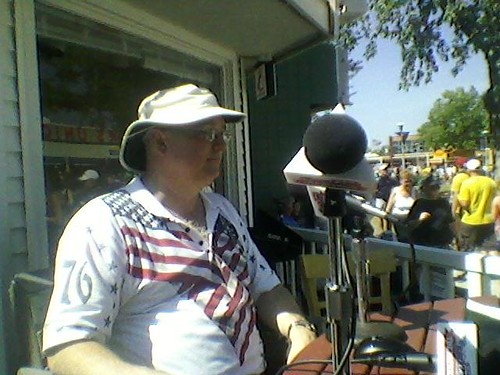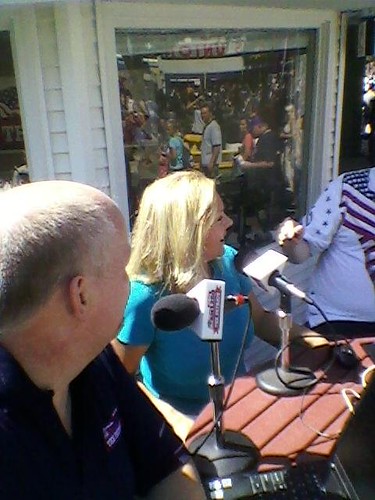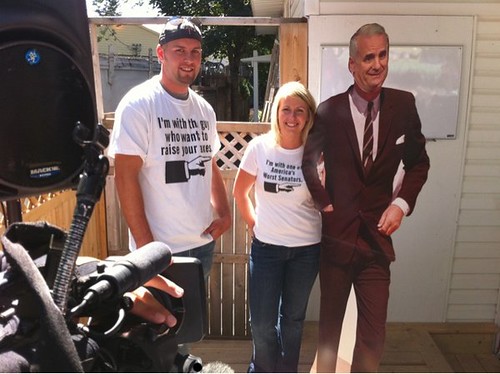It was seventy years ago today that the Battle of Britain entered its decisive phase.
Not its bloodiest phase; that was yet to come.
But it was over the next month that the fate of Britain – and, to an extent, of Western Civilization – was decided. Because it was in the next thirty days that the outcome of the Battle hung by its thinnest thread.
Historians debate just how thin that thread got – more on that later – but the thirty days starting today were, if not the tipping point, at least the point at which the direction of the tip was decided.
Although neither side really knew it at the time.
The Luftwaffe had spent the previous ten days pummeling Britain’s radar stations. On the one hand, it was a smart idea, decades ahead of its time. On the other hand, it’d take a couple of decades to develop the tools and techniques that’d make radar stations a viable target for air attack. The Germans felt the attacks were achieving little, at immense cost (especially to the Stukas, which were brutalized by British Hurricane fighters seventy years ago yesterday to the point they were largely pulled from the lineup), with little chance of long-term success. The first conclusion was valid under the circumstances; the second, the losses, were apparent; the third – the long-term prognosis – was very much a matter of conjecture.

Hurricane pilots scrambling to meet a raid.
But no matters. Seventy years ago today, Hermann Göring ordered the Luftwaffe to begin the next phase of the Battle; the destruction of Fighter Command’s airfields.
For the next two weeks, German bombers launched nearly thirty major raids on Fighter Command airfields, trying to destroy the hangars, control facilities, grounded planes, support crews and “runways”. The latter was difficult; most Fighter Command “airfields” were just that; flat, mowed fields. Repairing bomb damage was a matter of shoveling dirt into the bomb crater and steamrolling it into a compact flat surface.
The control facilities, though, were another matter. Built on the cheap during the rapid buildup before the war, most buildings on the operational bases were above-ground, wood-walled, tile-roofed huts, very susceptible to bomb damage. As the attacks build up, RAF engineers scrambled to build dirt berms around the squadron command posts, up to eave level, to protect them from blast damage. It worked, for the most part – only Biggin Hill’s HQ was destroyed, by a freak bomb hit (because most direct bomb hits were freaks of fate, back then).
The biggest damage was up in the air, though; each bomber raid was escorted by a swarm of German fighter aircraft. A German raid of 30-90 aircraft would have from 40 to 120 ME109 Jagdflieger, fighers, flying close escort around the bombers. The Brits would be dispatched in squadrons of 12 planes, directly at the raids. It tended to turn every battle into a “David vs. Goliath” fight – 12 Spitfires or Hurricanes against dozens of German fighters, to say nothing of the bombers.

A formation of German Heinkel 111 bombers
It sounds stupid – but there was method to the madness. British fighters – like their German counterparts – had very, very short “legs”; the Hurricane had a range of about 600 miles, the Spitfire even less, and that was at cruising speed.

Spitfire pilots racing to their aircraft during a "scramble" - a mad dash to get airborne to catch an incoming raid.
In an “intercept” situation – taking off, forming up the squadron and climbing at 2000+ feet per minute while following the control officers’ directions to intercept raids, with the throttle jammed to the firewall – the British planes could basically take off, find the raid, fight for half an hour, and return to base. There was rarely time to circle around and wait for more British fighters to show up.
Although that was a major contention in the upper ranks of RAF’s Fighter Command.
Southern Britain was divided up among three Groups; 10 Group, controlling the southwest; 12 Group, commanded by Air Vice Marshall Trafford Leigh-Mallory, covering the Midlands; and, in the southeast, closest to occupied France, 11 Group, commanded by Air Vice Marshall Keith Park.

The four Groups charged with Britain's air defense. 10, 11 and 12 were on the front lines. 13 Group, after giving unescorted German bombers flying from Norway a very bloody nose on "Adlertag", served mainly as a training area and a rest zone for squadrons exhausted by the fight in the south.
The men had similarities; both had joined the Army as privates at the beginning of World War I. Both had gotten commissioned as officers, then joined the Royal Flying Corps after being wounded in ground combat. Both distinguished themselves as pilots. Both rose steadily through the ranks.
But those were the only similarities. Leigh-Mallory had been a lawyer, son of a prosperous lawyer and bureaucrat who excelled at academics; Park, a New Zealander, the son of a mining company geologist, was an indifferent student, an outdoorsy hunting enthusiast.
And the two men sniped at each other, constantly, throughout the Battle.
Park favored the direct approach; sending squadrons barrelling into the German bomber formations as fast as they could get into action, without regard to forming them up into larger units.

Air Vice Marshal Keith Park
The one real refinement was his attempt to send the faster Spitfires after the German fighters, and letting the slower Hurricanes after the bombers. It was a formality, mostly; Hurricanes were 2/3 of the British inventory, and closer to 70% of Park’s order of battle. And so the 11 Group battle was largely one of harrying German bombers, quickly but piecemeal, before they could get to their targets.
Leigh-Mallory – and his top Wing Commander, the legendary Douglas Bader, who lost both legs around the knee in a pre-war flying accident, and returned to active duty in time for the Battle – favored the “Big Wing”; grouping 3-5 squadrons into a “wing” of 36-60 aircraft, and then throwing the “wing” at the German .

Air Vice Marshal Trafford Leigh-Mallory, commander of 12 Group. A capable commander, a salient intra-service politician.
The problem was, it took a while to get three to five squadrons up, off the ground and into the air and grouped together in the time available before the German raids actually hit their targets.

Squadron Leader Douglas Bader (fourth from right) with pilots from 242 Squadron during the Battle. Shot down over France later in the war, he spent the rest of the war as POW; even though legless, he earned the distinction of being sent to the most "escape-proof" POW camp - because of his many attempts to break out. That's cojones.
The conventional wisdom, built from decades of revisionist history, is that the two men eventually settled on a one-two punch; Park’s squadrons would hit the bombers as they came in to the attack; Leigh-Mallory’s Big Wing would catch them on their way home. In fact, it very rarely worked that way; Park’s squadrons bore the brunt of the fighting, while the Big Wing, flying in a huge mass around southern England once it formed up, rarely caught the eneny, and often confused the British ground controllers. Leigh-Mallory had the political clout; after the Battle, he managed to maneuver Park out of his position and get him sent to Training Command (although he went on to lead the air defense of Malta and then the air attack against Italy, and is generally regarded today as one of history’s great air commanders; he’s finally getting the recognition he deserves in the UK)

Statue of Keith Park, on the Fourth Plinth in Trafalgar Square. Like all Fourth Plinth statues, it's temporary. It's a shame.
Still – through a combination of British technological prowess and air-combat chops – and a few lucky breaks – the RAF wore down the Luftwaffe over the course of the next month to the point that it needed to switch to night-time terror bombings of British cities – “the Blitz” – which is the part most Americans know about, and ironically was the part that was of least importance in winning air superiority over Britain. Because once the Luftwaffe ceded control of the daylight sky over Britain to the RAF, and allowed Fighter Command to regain its strength once and for all, then in fact the bid to invade Britain ended for the rest of 1940 – which meant, in the end, for good.
As with all great events of World War II, there are lots of myths – and a few hidden stories.
Owed To So Few: It’s a constant contention among historians; some say that, between August 24 and September 15, the RAF’s supply of pilots was dwindling from the attrition. Others note that the supply of pilots actually rose – while the Luftwaffe’s aircrew ranks actually shrank during the Battle (normal, given they were flying over enemy territory’; if they bailed out or crash-landed, they’d be captured).
The answer, of course, is somewhere in between. While the number of pilots rose, they were often very, very new pilots, freqently with no air combat training. These pilots suffered grievous losses, until they survived enough missions to learn the trade.
So Many: One of the features about the British military, but especially the RAF, that surprises Americans the most is the huge number of nations represented by the RAF’s pilots. The RAF included Canadians (as members of RAF squadrons as well as a squadron of the RCAF), Australians, South Africans, Australians, New Zealanders (including Park), even a Jamaican pilot (indeed, Jamaicans – of African descent – flew as officers in the RAF throughout the war, side by side with white officers and with white aircrew).
The pilots in exile – the French and Norwegians who played such role in the RAF later in the war – hadn’t quite gotten up to speed yet.
But as the attrition of July and August began catching up with the RAF, the need for experienced pilots became overwhelming – so Fighter Command leader Air Marshall Hugh Dowding approved allowing a squadron of Poles into action, along with a few other Eastern European pilots who’d had nearly a years’ experience in combat already.
I wrote about the Poles last year – 303 Squadron ran up one of the most impressive scores of the battle – in a seventeen-day tear starting about this time 70 years ago.

Pilots of 303 Squadron
Some of these men were fighting in their third air force in under a year, having fought in Poland, France, and now the RAF.
Topping them all? Josef Frantisek, a Czech pilot who fled his homeland to Poland when Chamberlain sold it out to the Nazis. He fought with the Poles, flying an unarmed reconnaissance plane, sometimes attacking German ground troops with hand grenades.

Josef Frantisek
He then fled to France where he fought again, scoring between 7 and 11 kills before finally decamping to the UK, where he served in the RAF alongside the Poles in 303 (there was a Czech squadron forming, but he’d developed a tight relationship with his Polish comrades. He scored 17 more confirmed kills, becoming the highest-scoring ace of the Battle period, before dying in a crash while landing; he was either exhausted or showing off for his girlfriend; either would have been in character for the colorful Czech.
Spitfire Vs. Hurricane: The Supermarine Spitfire is largely regarded as the hero of the Battle.

The Supermarine Spitfire
The sleek, elliptical-winged Spitfire – one of the most beautiful aircraft ever built, did become one of the most important air superiority fighters of the war. It stayed in production until 1946, longer than any other World War II fighter. And it lent not only its Rolls-Royce Merlin engine, but some of its design lessons, to the American P51 Mustang – the greatest piston-engined fighter ever made.
But it didn’t win the Battle.
The Spitfire, at the beginning and throughout the Battle, was about a third of the RAF’s fighter inventory. The other 2/3 were the humbler, lesser-known Hawker Hurricane:

A vic of Hawker Hurricanes
The Hurricane – Britain’s first single-wing, mostly-metal fighter plane – was about a year older than the Spitfire. It was a little slower on the straightaway and in the climb, could turn tighter, and would shake and swerve a lot less when its eight Browning .303-caliber machine guns (same as the Spitfire) opened up, making it easier to aim and hold a target in the crosshairs. It could also take more damage and stay flying; its skin was made of doped muslin fabric aft of the cockpit, which sounds archaic but was nearly as strong as aluminum (close enough for the purposes); repairing a bullet hole was as simple as gluing on a fabric patch.
The Hurricane peaked during the Battle; it was quickly relegated to ground-attack duty, and finally shipped off to secondary fronts like India and Burma, while the Spitfire – which had more development potential – evolved with new engines and bigger guns over the course of the war.
But the Hurricane’s role in history – it was not only 2/3 of the RAF’s fighter inventory, but scored 2/3 of the RAF’s kills – was a matter of historic record, if not necessarily public imagination. Author Paul Gallico felt the need to set the record straight in his book, The Hurricane Story. It’s worth a read, if you can find it.
But behind the never-ending battle between Spitfire enthusiasts and Hurricane partisans lay the real important point; the British built more of both than the Germans did of their own aircraft. But the British didn’t know how few aircraft the Germans could produce, and the Germans had no idea how fast British aircraft factories and repair shops could work.
Which leads us to…
Military Intelligence: As with the second phase of the Battle – when the Germans broke off their attacks on the radar sites – both sides’ intelligence failed them.
The Germans believed the British aircraft industry was on the ropes, even as production of Hurricanes and Spitfires ramped quickly up to a point where even the worst weeks’ worth of losses didn’t make a dent in the number of planes in the air. (Pilots were, arguably, another story). The productivity of the British aircraft industry was one of the great triumphs of the war – but the Germans didn’t figure this out until far too late.
The British, on the other hand, heavily overestimated the planes German could produce. The end result was, while conventional history says the Luftwaffe outnumbered the RAF, the fact is that by September, the RAF outmatched the Germans in sheer numbers of fighters (and would soon beat them at bombers as well.
So throughout the Battle, the Germans consistently were surprised at how many RAF fighters there still were; the British constantly expected a huge onslaught of fresh reserve German aircraft that never materialized.
The Terrorist: Conventional wisdom was correct in that the beginning of the end of the Battle came when Germany stopped bombing the airfields, around September 14, and switched to terror-bombing British cities.
The conventional wisdom misses that there was a three week period in which the biggest opponent of bombing the cities was…Hitler.
Hitler barred the bombing of London and the indiscriminate bombing of cities (although many civilians were killed and many civilian neighborhoods damaged during attacks on nearby ports, factories, airfields and military installations), even after the RAF bombed Berlin for the first time, seventy years ago this evening (August 25). History records that the decision was made as a result of Luftwaffe chief Hermann Göring’s bruised pride, having promised on German radio that Berlin was totally safe. In fact, it was a reaction to the exhaustion and casualties the German bomber crews suffered over the following three weeks’ assaults on RAF airfields and factories – a decision RAF Bomber Command made itself before long, and that the US Eighth Air Force was very nearly forced to make, for the same reasons, in 1943.
———-
Churchill said, after the Battle, that never in history had so many people owed so much to so few; and while there were rather more RAF pilots than the conventional wisdom would hold, it was still a tiny number. There were between 1,000 and 1,400 or so RAF fighter pilots at any given point during The Battle; maybe three times as many Germans (because of the bombers’ four-man crews). Compare that number with those engaged in the war’s other pivotal battles; the tens of thousands of sailors in the Battle of the Atlantic or Midway; the hundreds of thousands at El-Alamein, D-Day and the Bulge; the millions at Stalingrad and Kursk.
Errors in conventional wisdom don’t change the fact; Churchill was right.


































